

Climate Change Takes a Toll on Cultures. Associated PressA member of Colombia’s indigenous Nukak-Makú people.

Climate change will only hasten a trend in which members resettle in urban areas when they come of age, environmental experts warn. There are nearly 7,000 known languages in the world today. It is predicted that half of these, in many cases vessels of indigenous cultures, will vanish over the next 50 years. This has been much on the mind of Brigitte Baptiste, who took over this year as director of the Colombian Environment Ministry’s Alexander von Humboldt Biological Resources Research Institute. Although rigorous assessments of indigenous vulnerability have been few and far between, she says, climate change is known to cause shifts in the growth of flora and fauna in local ecosystems, from animal migrations to natural cycles like pollination.
Indigenous Health and Climate Change. On the Frontlines of Climate Change. Indigenous Peoples. In North America, indigenous peoples include American Indians and Alaskan Natives.
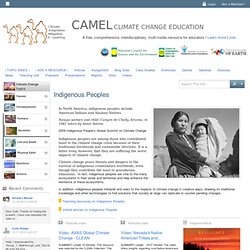
Navajo women and child, Canyon de Chelly, Arizona, in 1941 taken by Ansel Adams. Indigenous Peoples and Climate Change in International Processes. NCCARF - National Climate Change Adaptation Research Facility. Abstract Aboriginal communities in north-western Australia are likely to be disproportionately affected by climate change.

Direct environmental impacts from predicted outcomes will exacerbate present difficulties in many Indigenous communities beset by social and economic disadvantages. In 2012 Indigenous people held land interests in about 80 per cent of northern Australia. Indigenous frameworks for observing and responding to climate change in Alaska. Despite a keen awareness of climate change, northern Indigenous Peoples have had limited participation in climate-change science due to limited access, power imbalances, and differences in worldview.
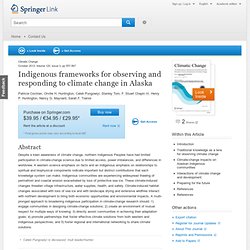
A western science emphasis on facts and an indigenous emphasis on relationships to spiritual and biophysical components indicate important but distinct contributions that each knowledge system can make. Indigenous communities are experiencing widespread thawing of permafrost and coastal erosion exacerbated by loss of protective sea ice. These climate-induced changes threaten village infrastructure, water supplies, health, and safety. Climate-induced habitat changes associated with loss of sea ice and with landscape drying and extensive wildfires interact with northern development to bring both economic opportunities and environmental impacts. Caleb Pungowiyi is deceased; Inuit leader/hunter. Indigenous peoples hardest hit by climate change describe impacts. Public release date: 2-Apr-2008 [ Print | E-mail Share ] [ Close Window ] Contact: Terry Collinsterrycollins@rogers.com 416-538-8712United Nations University Indigenous peoples have contributed the least to world greenhouse gas emissions and have the smallest ecological footprints on Earth.
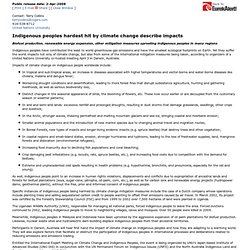
These Countries Face The Biggest Threats From Climate Change. Native American Communities Affected by Climate Change Plan for the Future. JEFFREY BROWN: There’s another big meeting taking place in Washington this week.
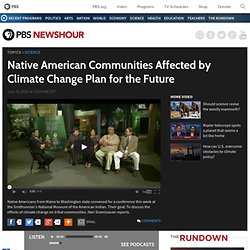
Native populations from around the U.S. convened at a conference on the impacts of climate change. Hari Sreenivasan has that story. And YASunidos Urge The European Parliament To Hold Hearing On World´s Most Biodiverse Area Under Threat. November 6, 2013.
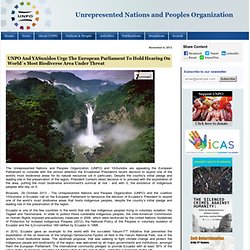
Climate change expected to wipe some French Polynesian islands off map. Updated at 5:30 am on 15 December 2011 A conference this week in Tahiti says some of French Polynesia's islands will be wiped off the map due to global warming.
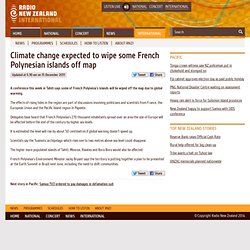
The effects of rising tides in the region are part of discussions involving politicians and scientists from France, the European Union and the Pacific Island region in Papeete. Delegates have heard that French Polynesia's 270 thousand inhabitants spread over an area the size of Europe will be affected before the end of the century by higher sea levels. It is estimated the level will rise by about 50 centimetres if global warning doesn't speed up. Scientists say the Tuamotu archipelago which rises one to two metres above sea level could disappear. The higher more populated islands of Tahiti, Moorea, Raiatea and Bora Bora would also be affected. Copyright © 2011, Radio New Zealand. Press_release_ar5_wgi_en. Climate Scientists to Attend Native Knowledge ‘Boot Camp’ in Australia.
World Heritage and Climate Change: Lessons From Indigenous Peoples of Altai, Russia. Shaman Maria Amanchina stands over the tomb of the Ukok Princess Kadyn.
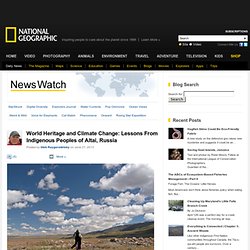
Photo © Gleb Raygorodetsky. The sacred Ukok Plateau at the heart of the Golden Mountains of Altai World Heritage Site, Russia, is changing because of climate. For local people, dealing with climate change means restoring and sustaining the role of the ancestral burial kurgans and other sacred sites in protecting Altai and its people. On a warm summer’s day twenty-four centuries ago, a noblewoman of the nomadic Pazyryk tribe was buried in a large ancient burial tomb, or kurgan, on the Ukok Plateau — now a region of the Russian Altai that borders China, Mongolia and Kazakhstan.
Mummified with herbs, bark and marten fur, she was placed in an oversized sarcophagus hewn from a single larch log. Indigenous Groups Rally to Rescue North America’s Freshwater. As the U.N. marks the International Day of the World’s Indigenous Peoples on August 9, we’re happy to give an update on a great example of the active role indigenous people and cultures have come to play in major issues like conservation around the world.
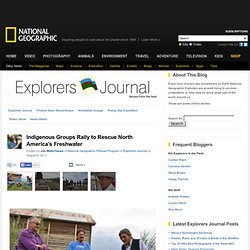
Our recent summit in Mayo, Yukon gathering indigenous groups to make a plan for the exertion of Native Water Rights in Canada and the U.S. was, in a word, perfect. Beyond the sunshine and blue skies, our giant white meeting tent was erected in a large grassy field beside the calm waters of the Stewart River. For 3 days, approximately 300 people gathered near the water’s edge, grateful to Mother Earth for her many bounties, and reveling in an atmosphere filled with appreciation and anticipation. Native People from all over Canada and Alaska arrived by plane, by bus, by car and boat. Learn More Read More From Jon Waterhouse. Indigenous knowledge to combat climate change. (Transcript from World News Australia Radio) Indigenous representatives from around the world have told a forum in Darwin that traditional land management practices are helping to combat the effects of climate change. The inaugural World Indigenous Network Conference has brought together 1200 delegates from countries across the Asia Pacific region as well as from South-East Asia, South America and Africa.
Delegates from a number of countries have shared their experiences on how traditional customs have helped them protect their local environments and pass on environment protection practices from one generation to the next. There has been a strong presence from Indigenous communities across the Pacific region at the Darwin forum with speakers from New Zealand, the Solomon Islands and Papua New Guinea. One speaker was the Paramount Chief of the Ngati Tuwharetoa people of New Zealand, Sir Tumu Te Heuheu. Changing With the Land: The Skolt Sámi’s Path to Climate Change Resilience. This photo essay offers a glimpse of the challenges that climate change presents for indigenous and local communities in northern Europe. An Arctic people of northern Finland whose livelihoods depend largely on their environment, the Skolt Sámi are searching for ways to remain resilient in the face of climate change. The land around Rautujärvi Lake, over 400 km above the Arctic Circle near the Norwegian and Russian borders, is home to the Skolt Sámi — reindeer herders and fishermen whose traditional ways are closely intertwined with the northern climate.
Photo: © Gleb Raygorodetsky 2012. The radiant disk of the Arctic sun hangs in the mid-September sky above northern Finland, like a ritual Sámi drum pinned to the wall inside a lavvu, a traditional Sámi dwelling. Arctic Indigenous Peoples, Displacement, and Climate Change: Tracing the Connections. For thousands of years, Arctic peoples have migrated in response to changing environmental conditions. But today climate change is putting unprecedented pressure on those indigenous communities. Temperatures are rising much faster in the Arctic than in the rest of the world, raising questions about the extent to which significant numbers of indigenous people will move away from their traditional habitats and whether they will be able to maintain their cultures and livelihoods.
Strangers of their own Land: Arctic Regions. Arctic Fix: Does Castration Help Reindeer Cope with Climate Change? If Rudolph wants to adapt to global warming, he may have to lose his most precious assets. (via AlertNet) Or so say experts among the Sami—an indigenous people who occupy the northern extremes of Finland, Norway, and Sweden, and the Kola Peninsula of Russia. As temperatures vary more in the Arctic region, snow thaws, re-freezes and forms a thick layer of ice over the pastures where they graze, forcing the animals to break through using their hooves and antlers.
Research by the Sami suggests that neutered males grow larger, and that makes them better at digging for food. Castrated males also keep their antlers for much of the winter; their intact counterparts shed them in the autumn after mating season. (More on NewsFeed: Wounded Fox Shoots Man. As with humans, the penis often leads males to think only of themselves. That tradition stops short of full-on nip and tuck. (More on NewsFeed: German Zoo Attempts to Re-Orient Gay Vultures.)
The Yup'ik Eskimos are the world's first climate-change refugees. A special report by Ed Pilkington. Brazil: Indigenous voices and the climate change debate. Indigenous peoples at forefront of climate change offer lessons on plant biodiversity.